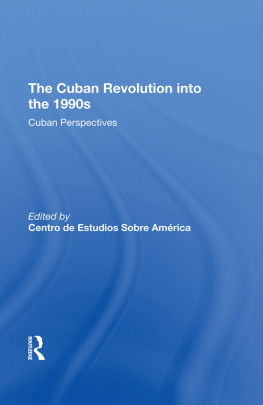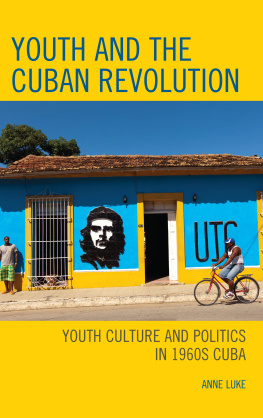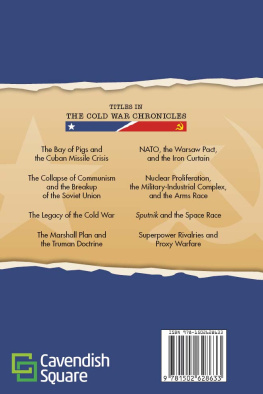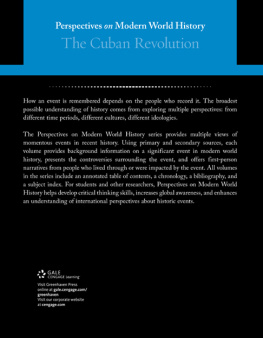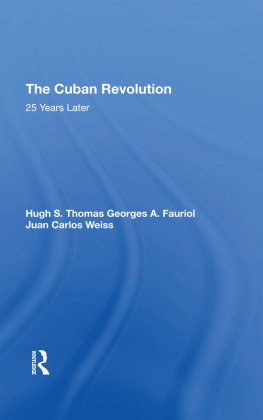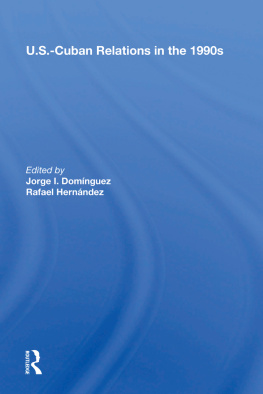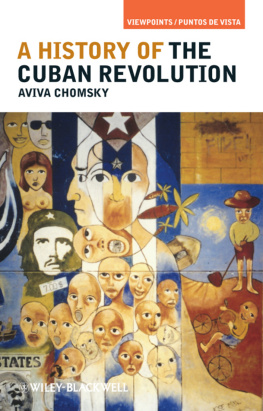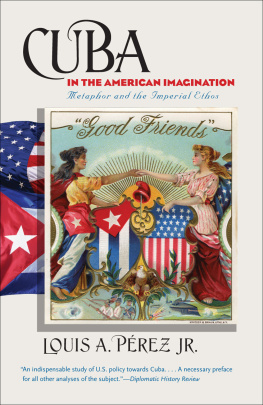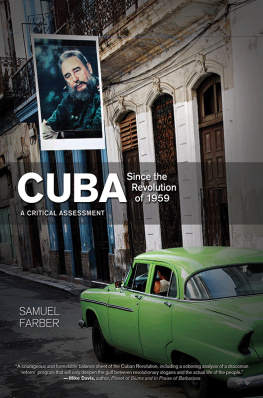The Cuban Revolution into the 1990s
Latin American Perspectives Series
Ronald H. Chilcote, Series Editor
Haiti in the World Economy: Class, Race, and Underdevelopment Since 1700, Alex Dupuy
The Battle for Guatemala: Rebels, Death Squads, and U.S. Power, Susanne Jonas
Repression and Resistance: The Struggle for Democracy in Central America, Edelberto Torres Rivas
Radical Thought in Central America, Sheldon B. Liss
Marxism, Socialism, and Democracy in Latin America, Richard L. Harris
Cuba in Transition: Crisis and Transformation, edited by Sandor Halebsky, John M. Kirk, Carollee Bengelsdorf, Richard L. Harris, Jean Stubbs, and Andrew Zimbalist
The Cuban Revolution into the 1990s: Cuban Perspectives, edited by Centro de Estudios Sobre Amrica
Available in hardcover and paperback.
First published 1992 by Westview Press
Published 2019 by Routledge
52 Vanderbilt Avenue, New York, NY 10017
2 Park Square, Milton Park, Abingdon, Oxon OX14 4RN
Routledge is an imprint of the Taylor & Francis Group, an informa business
Copyright 1992 Taylor & Francis
All rights reserved. No part of this book may be reprinted or reproduced or utilised in any form or by any electronic, mechanical, or other means, now known or hereafter invented, including photocopying and recording, or in any information storage or retrieval system, without permission in writing from the publishers.
Notice:
Product or corporate names may be trademarks or registered trademarks, and are used only for identification and explanation without intent to infringe.
Library of Congress Cataloging-in-Publication Data
The Cuban Revolution into the 1990s: Cuban perspectives / edited by
Centro de Estudios Sobre Amrica.
p. cm. (Latin American perspectives series ; no. 10)
Includes bibliographical references and index.
1. CubaPolitics and government1959- 2. CubaEconomic
conditions1959- 3. CubaSocial conditions1959- I. Centro de
Estudios Sobre Amrica. II. Series.
F1788.C829 1992
972.91064dc20
92-14477
CIP
ISBN 13: 978-0-367-29112-9 (hbk)
Contents
, Ronald H. Chilcote
PART 1
Democracy and Socialism
, Julio Carranza Valds
, Juan Antonio Blanco
, Rafael Hernndez and Haroldo Dilla
, Georgina Surez Hernndez
, Fernando Martnez Heredia
, Armando Hart Dvalos
PART 2
Economic Development
, Carlos Tablada
, Jos Luis Rodrguez Garca
, Miguel Alejandro Figueras
, Miguel Alejandro Figueras
PART 3
Social Questions
, Juan Luis Martn
, Ins Cristina Reca
, Manuel Limonta Vidal and Guillermo Padrn
, Ral Gmez Treto
Guide
Ronald H. Chilcote
The Cuban Revolution succeeded in 1959 in the face of official U.S. opposition, an abortive Bay of Pigs invasion, and an economic embargo. Cuban dependence on the United States dated to the U.S. occupation of the island from 1898 to 1901 and subsequent interventions in 19061909, 1912, and 1917. Historically, the Cuban economy has depended on the export of sugar. Before the revolution the United States imported the largest share of Cuban sugar; after 1960 the Soviet Union assumed this role, and in exchange Cuba had to import its fuel and some of its foodstuffs, raw materials, and capital goods.
Early efforts at central planning in a previously undisciplined economic system encountered many problems. Foreign exchange reserves declined, and raw materials for new factories had to be imported at prices exceeding the cost of importing many finished goods. The goal of producing 1 million tons of sugar in 1970 was not achieved. There were, however, some advances, including new technology for sugarcane production and the commercialization of many by-products, diversification into other agricultural products, crossbreeding to produce cattle both resistant to the tropical climate and capable of producing greater quantities of milk, and expansion and modernization of the fishing industry. According to Andrew Zimbalist, from 1960 to 1985 Cuba outperformed the rest of Latin America, with real per capita income increasing an average of 3 percent compared with less than 2 percent, a substantially more equitable distribution of income, and unemployment well below the Latin American average ( Multinational Monitor , April 1989). The revolutions objective of providing all Cubans with free services in areas of basic needs such as health, education, welfare, and housing led to spectacular advances in health care (in particular, an integrated system of prevention and treatment) and in nutrition, water, and sewage disposal, the reduction of illiteracy to less than 4 percent of the population, and the construction of new housing that, however, failed to keep pace with the demand created by concentration in certain areas and population growth. Politics revolved around the charismatic personality of Fidel Castro, who had led the abortive assault on the Moneada barracks in 1953 and the guerrilla struggle later in the decade. The Partido Comunista de Cuba (Communist Party of Cuba, PCC) dominated political life at the top, but other political institutions were also important: Poder Popular (Peoples Power), a system of elected peoples assemblies at the municipal, provincial, and national levels; local Comits de Defensa de la Revolucin (Committees for the Defense of the Revolution, CDRs), charged with guarding against counterrevolutionary activities and serving neighborhood needs; and popular courts (tribunales populares) to deal with disputes and petty crimes at the neighborhood level.
In 1989, as the Berlin Wall crumbled, the command socialist economies of Eastern Europe began to collapse one after another, and the Soviet Union moved toward a market economy, the Cuban economy was confronted with serious problems. The reduction of Soviet petroleum deliveries by 25 percent led to an energy crisis and the loss of a surplus normally reexported for needed hard currency. The unification of Germany deprived Cuba of its second-largest trading partner. Its foreign commerce was further undermined by the abandonment of the system of barter and preferential prices maintained by the Soviet Union and its former Eastern European partners and by the need to trade in hard (dollar) currency. Under the trade agreement with Moscow signed in December 1990, Cuba would pay more for Soviet petroleum and receive less for sugar, assume some of the shipping costs formerly absorbed by Moscow, and lose the services of a thousand Soviet technicians.
In an attempt to accommodate both the U.S. embargo and the changing Soviet relations, Cuba embarked on an emergency program of energy reduction and food rationing. While Cubans had long ago learned to deal with shortages and make sacrifices, the crisis necessitated new thinking, the raising of new questions, and the reworking of old ideas in creative and refreshing ways. Cuban intellectuals and academicians are today undertaking these tasks. Their work suffered in the early years both from the amount of effort required to accomplish the goals of the revolution and from problems characteristic of the Third World such as poor training and lack of skills, shortage of resources, and limited attention to scholarship outside priority areas. Moreover, the threat of U.S. imperialism meant that they worked in an atmosphere of vigilance against counter-revolutionary activities, a controlled press, and constraints on political activity. Although the quality of academic work has gradually improved over the years, scholarship has necessarily focused on policy questions as intellectuals assess successes and failures and search for a better society in the face of the seemingly insatiable demands of the international capitalist order. This volume brings together some of their perspectives on issues that include not only economic adjustments but the expansion of political opportunities, the enhancement of the notable social advances of the revolution, and the identification of a role for the highly educated and skilled younger generation that will eventually assume positions of responsibility.

